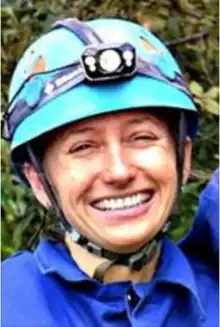Becca Peixotto | |
|---|---|
 | |
| Nationality | American |
| Education |
|
| Known for | Discovery of Homo naledi[2] |
| Scientific career | |
| Fields | Anthropology Archaeology |
| Institutions | American University |
| Thesis | Against the Map: Resistance Landscapes of the Great Dismal Swamp |
| Doctoral advisor | Dr. Daniel O. Sayers |
Rebecca (Becca) Peixotto is an American archaeologist who is best known for her contribution to the Rising Star Expedition as one of the six Underground Astronauts, a group of scientists tasked with excavating the Rising Star Cave System.[3] She has also participated in the Great Dismal Swamp Landscape Study and is an experienced wilderness educator.[4]
Education
Peixotto received her Ph.D. in Anthropology, Archaeology Specialization, in 2017 from American University with her dissertation Against the Map: Resistance Landscapes of the Great Dismal Swamp.[5] Peixotto obtained a B.A. in Slavic Area Studies and Mathematics from the University of Alabama in Huntsville.[1] She pursued further studies abroad at the University of Amsterdam, obtaining an M.A. in Discourse and Argumentation Studies. She returned to the U.S. to attend the American University in Washington, DC, where she earned a M.A. in Public Anthropology, Archaeology Specialization, in 2013.
Rising Star Expedition
In October 2013, Peixotto and five others were chosen to be part of a specialized excavation team for the Rising Star Expedition.[6] The purpose of the 21-day expedition, sponsored by The National Geographic Society and the University of the Witwatersrand, Johannesburg, was to excavate fossils which had been recently found in a deep cave complex in the Rising Star Cave System, near Johannesburg, South Africa.[7]
The critical skills and physical attributes sought for the excavation team by lead scientist and University of the Witwatersrand professor Lee Berger were a "master's degree or higher in palaeontology, archeology or an associated field; caving experience; and the ability to fit through an 18-centimeter (about 7-inch) space."[8] The six women scientists were crucial in the successful "excavation of arguably one of the most important fossil finds in human history – a new species referred to as Homo naledi."[9]
Peixotto, Hannah Morris, Marina Elliott, Alia Gurtov, K. Lindsay Eaves, and Elen Feuerriegel, along with a team of sixty international scientists, excavated "one of the richest collections of hominin fossils ever discovered—some 1,550 fossil fragments, belonging to at least 15 individual skeletons."[6]
Since this expedition, Peixotto has continued to work with a team to learn more about Homo naledi.[10] As of 2021, this team has discovered two dozen naledi individuals and evidence that suggests this cave system might have served as burial grounds for Homo naledi.[10]
Publications (selected)
- 2021. Montgomery, A, and Peixotto, B. Explore Paleoanthropology Fieldwork: A Virtual Expedition to Rising Star Cave (South Africa) with DinalediVR. American Biology Teacher, in press.
- 2021. Peixotto, B, Klehm, C, Eifling, K. Rethinking Field Sites as Wilderness Activity Sites. Advances in Archaeological Practice special issue Health and Wellness in Archaeology: Improving Wellness and Response, in press.
- 2020. Peixotto, B, Elliot MC. Meet Neo: Your Ancient Cousin. Frontiers for Young Minds 7:155. doi: 10.3389/frym.2019.00155.[11]
Awards and honors (selected)
Early life
As a child, Peixotto enjoyed searching her grandparents’ old Vermont farmhouse for artifacts.[16][17] She initially studied engineering at college, but according to Peixotto, "When I took my first archaeology course, it was like a lightbulb turned on! I could combine all my experiences and interests in science, the outdoors, teaching, and history, to learn more about our collective human past."[16]
Peixotto was a Girl Scout.[17]
See also
References
- 1 2 "Faculty Profile Rebecca Peixotto". American University Washington D.C. Retrieved 31 March 2022.
- ↑ Weisser, Ryan (30 September 2015). "Meet the Local Student Who Helped Discover a New Species". Washingtononian. Retrieved 31 March 2022.
- ↑ Feltman, Rachel. "Meet the six female 'underground astronauts' who recovered our newest relative". Washington Post. Retrieved 31 March 2022.
- ↑ "Who are the Underground Astronauts". EWN. Retrieved 31 March 2022.
- ↑ Peixotto, R. A. (2017). Against the Map: Resistance Landscapes in the Great Dismal Swamp. American University (thesis). doi:10.17606/4a1s-1312.
- 1 2 Yong, Ed (10 September 2015). "6 Tiny Cavers, 15 Odd Skeletons, and 1 Amazing New Species of Ancient Human". The Atlantic. Retrieved 31 March 2022.
- ↑ Shreeve, James (10 September 2015). "This Face Changes the Human Story. But How?". National Geographic. Archived from the original on September 10, 2015. Retrieved 31 March 2022.
- ↑ "Ali Gurtov '07 Is One of The Rising Star Expedition's "Underground Astronauts"". Wellesley College. Retrieved 31 March 2022.
- ↑ Mathy, MH (13 October 2015). "Shining Light of Discovery". The Clarion. Retrieved 31 March 2022.
- 1 2 Woodward, Aylin. "A child's skull found deep inside a South African cave offers new clues about a group of mysterious human ancestors". Business Insider. Retrieved 2022-04-09.
- ↑ Peixotto, Becca; Elliott, Marina C. (2020). "Meet Neo: Your Distant Cousin?". Frontiers for Young Minds. 7. doi:10.3389/frym.2019.00155.
- ↑ "Smithsonian puts focus on STEM standouts for Women's History Month". Washington Post. ISSN 0190-8286. Retrieved 2022-04-01.
- ↑ "IF/THEN Ambassadors reflect on their first year". Association of Science and Technology Centers. 2020-09-10. Retrieved 2022-03-31.
- ↑ ECWG_Admin (11 January 2017). "2016 Exploration and Field Research Grant Recipients – Explorers Club Washington Group". Retrieved 2022-03-31.
- ↑ "Flag Carriers". WINGS WorldQuest. Retrieved 2022-03-31.
- 1 2 "Dr. Becca Peixotto: Digging Deep". Museum of Life and Science. 2021-10-01. Retrieved 2022-03-31.
- 1 2 "| IF/THEN® Collection". www.ifthencollection.org. Retrieved 2022-03-31.